Concrete roof tile has been growing in popularity since the 19th century. Since then, it has improved both in quality and appearance, even though it’s still considered inferior to its clay counterparts. It’s true that despite its many beneficial qualities, the material may not be compatible with every home.
To consider if it would make a suitable roofing material for you, check out the pros and cons of concrete roof tiles below.
What Is Concrete Tile Roof
Concrete roof tiles are made from a mixture of sand cement water and iron oxide, then processed under high temperature and high pressure, contributing to their durable shape and strength. This makes them highly resistant to high winds and extreme weather conditions.

Many homeowners have been wondering: are concrete roofs good? Similar to asphalt roof solutions, the quality of concrete tiles largely depends on their sources and, often, their cost. Those at the lower end of the price spectrum might not perform as well after 20 years, a consideration similar to asphalt shingles.
Those categorized at the cheaper end of the spectrum usually have an obvious concrete appearance and coated paint to make them mimic slate or clay tiles. Their quality is also inferior as they’re more prone to damage and fading.
Those that fall on the more expensive side can have extremely convincing visuals with great color depth and a lot of texture.
Concrete roof tiles have an impressive lifespan, thanks to their inherent toughness. They last a minimum of 50 years, though with proper maintenance, this could extend further, depending on the location and whether your roof requires additional care. This significant duration of life ultimately results in money-saving benefits as well because you won’t have to replace the roof material as often.
Concrete Roof Tiles Pros and Cons
Below are the advantages and disadvantages of concrete roof tiles to help you decide if they’d make the ideal option for your home.
Pros:
- Affordability – The average concrete roof tiles installation cost is $3-$5 per sq ft, which is less expensive than other roofing options, especially clay tiles.
- Versatility – Concrete tiles can be made to mimic the shape, color, and texture of clay, slate, wood shake, and stone roof tiles.
- Wind, Impact, and Fire Resistance – This roofing material boasts 180 mph wind speed resistance. It is rated Class 4 for impact and Class A fire rating for fire resistance, offering top-tier safety for residential properties.
- Energy-efficient – Using concrete as their base material makes the roof tiles capable of transferring low heat to keep the property cool during summer and warm during winter.
- Long lifespan – Concrete tiles have a lifespan of 30-50 years. This range is not as extensive as clay roof tiles, with a life expectancy of 100 years, but it is still better than most roof materials.
- Low Maintenance – Compared to clay tiles, concrete tiles need slight maintenance but it only requires recoloring work in case some fading occurs.
Cons:
- Weight – Concrete tiles are known for their heavy weight, often ranging from 500 to 720 pounds per 100 square feet. Modern advancements have reduced their weight but typically require structural reinforcement to ensure that your home’s structural support can handle the load.
- Color Fading – As the tiles age, they may experience fading color pigmentation issues. This problem may appear if the tiles are coated with paint instead of being given color treatment during the forming process.
- Efflorescence – The term ‘efflorescence’ refers to the appearance of white chalky matter on the tiles’ surface. Compared to clay tiles, concrete roofs have more porosity, absorbing water more easily. This condition makes the tiles appear stained, but it can be fixed by cleaning off the tiles.
Utilizing the cons of concrete roof tiles and the pros listed above will help you determine if this roofing system is right for your property. Concrete roofs are a cost-effective option, and understanding the cost of concrete roof tiles can help you budget effectively.
If their disadvantages are significant for your situation, exploring other roofing materials available on the market might be beneficial.
